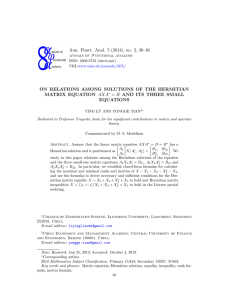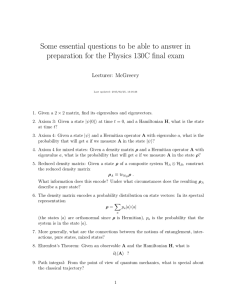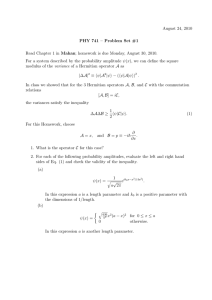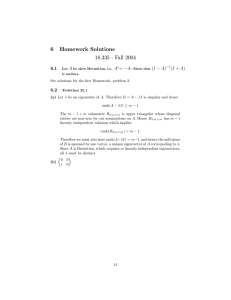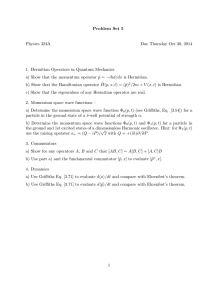M-ideals in B(lp)
advertisement
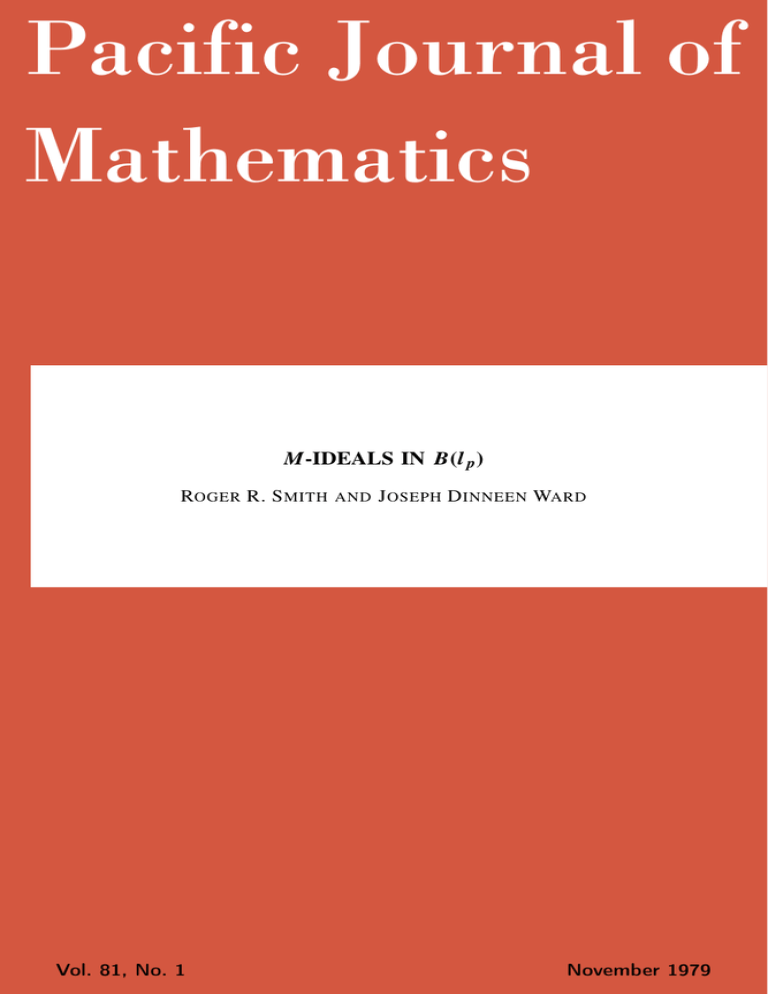
Pacific Journal of
Mathematics
M-IDEALS IN B(l p )
ROGER R. S MITH AND J OSEPH D INNEEN WARD
Vol. 81, No. 1
November 1979
PACIFIC JOURNAL OF MATHEMATICS
Vol. 81, No. 1, 1979
M-ΪDEALS IN B{lp)
R. R. SMITH AND J. D.
WARD
This paper is concerned with the M-ideal structure of
the algebras B(lp) of bounded operators on the sequence
spaces lp, 1 < p < oo. The M-summands are completely
determined, but the M-ideals are only partially characterized.
However evidence is presented to support the conjecture
that the only nontrivial M-ideal is the ideal C(lp) of compact
operators on lp.
1*
Introduction* It has been observed by several authors that
various structure theorems for B(H), H a separable Hubert space,
can be extended to the spaces B(lp), 1 < p < oo. For instance, it is
known that the ideal C(lp) of compact operators in B(lp), 1 < p < oo
is the only closed nontrivial two sided ideal [9], and Cac [5] has
shown that the second dual of this space is isometrically isomorphic
with B(lp). In another direction Hennefeld [10] proved that C(lp) is
an M-ideal in B(lp), 1 < p < °°. The notion of an M-ideal generalizes
the two sided ideals in a C*-algebra; due to the geometric characterization of the ideals in these special algebras the M-ideals have been
identified with the two sided ideals [13].
The present work arose from an attempt to extend the latter
result on M-ideals to B(lp), 1 < p < °o. Although the M-ideals in
B(lp) are not yet completely characterized, certain positive results
are obtained. For instance, in B(lp) the M-summands, a special
subclass of M-ideals, are described. Moreover, it is shown that C(lp)
is a minimal M-ideal in B(lp), 1 < p < °o, in the sense that every
nontrivial M-ideal in B(lp) contains the ideal of compact operators.
The techniques developed herein yield a new proof that the M-ideals
must be two sided ideals in a C*-algebra. In addition, certain
structure theorems on the state space of B(lp), 1 < p < oo and on
the hermitian elements of B(lp)** are derived.
2* Preliminaries* A closed subspace N of a Banach space X
is said to be an L-ideal if there exists a closed subspace N' such
t h a t X - N®N' and \\n + n'\\ = ||τι|| + \\n'\\ for all ne N and n'eN'.
A closed subspace J is said to be an M-ideal if the annihilator J~ is
an L-ideal in X*. A closely related concept is that of an M-summand
which is defined to be an M-ideal J with a complementary closed
subspace J' such that \\j + i'|| = max {||i||, ||i'ίj} for all jej
and
j ' e J'. It should be noted that M-ideals need not be M-summands.
The detailed properties of these objects have been studied in [2],
227
228
R. R. SMITH AND J. D. WARD
and in particular the annihilator of an L-ideal is an Λf-summand,
while the dual statement is true for the annihilator of an Msummand.
The ikf-ideal structure of Banach algebras was investigated in
[13] and the results relevant to this paper are summarized below.
Let A be a Banach algebra with identity e and let J be an Λf-ideal
in A. Denote by S the state space of A defined to be {<ρeA*: \\φ\\ =
1
φ{e) — 1}. Then J and its complementary L-ideal, when intersected
1
with S, yield a pair of complementary split faces F and F respecLL
tively of S [13]. J is an ilf-summand in A** with complementary
Λf-summand J11' and Pe — z is an hermitian projection in A**,
where P is the projection of A** onto J 1 1 . If z is regarded as a real
valued affine function on S then z\F = 0 and z\F' = 1. In general
z is not the identity on the algebra JLL although if A is commutative then this is the case [12]. However the following relations
hold.
THEOREM
2.1. For an M-ideal J, zA**zaJlλ
and (e — z)A**(e — z)a
A1
J '.
If z is not the identity on J 1 1 then z does not commute with
every element of A**. However there is a class of elements for
which z is central, and this will be useful for later work.
LEMMA 2.2. Let J be an M-ideal in A with associated projection ^ e i * * . Then z commutes with every hermitian element of A**.
Proof. Let φ be a state in Ff so that z(φ) = 1, and define a
linear functional φz e A* by
Φ*ifl) = Φ&o,)
for all a e A. Since φz{e) = 1 it is clear that φz e S.
hermitian element of A** then φz(h)eR and so
If h is any
φ(zh) = φz(h) G R .
For a state ψeF, ^ (e _ z) 6 S and thus
ψ{(e - z)h) e R .
The element zh is seen to take real values on F and F' and it
follows then zh is hermitian since S = conv (F U Fr). Similar arguments imply that hz is also hermitian and so hz — zh is hermitian.
However i(hz — zh) is hermitian by [4, p. 47] and the only way to
reconcile these statements is to conclude that hz = zh.
itf-IDEALS IN B(lP)
229
In [13] it was shown that if A is a C*-algebra then the M-ideals
are closed algebraic ideals. It is interesting to note that this is an
easy consequence of the preceding lemma.
COROLLARY
2.3. The M-ideals in a C*-algebra A are closed
algebraic ideals.
Proof. The hermitian elements span A and so z is central in
A**, by Lemma 2.2. The result follows from Theorem 2.1.
3Φ -M-sumrαands in B(lp). Henceforth the study of M-ideals
will be concentrated on the classical Banach spaces of bounded
operators on the sequence spaces lp. The restrictions will be made
that 1 < p < co and that p Φ 2. For p = 2, B(l2) is a C*-algebra
and so the results to be obtained in the general case are trivial
consequences of [13, §5] for this space. The spaces with indices 1
and oo differ markedly from those considered here, and some indication of this will be given in a later section.
The first results concern ϋί-summands in B(lp) and for these a
theorem due to Tarn will be needed.
3.1 (Tarn [15]). The hermitian operators in B{lp),
1 < 2 > < ° ° P Φ 2, are precisely the diagonal operators with respect
to the canonical basis {βJΓ=i possessing real entries.
THEOREM
THEOREM
3.2. There are no nontrivial M-summands in B(lp),
1 < p < oo.
Proof. The case p = 2 will be considered later and so suppose
that p Φ 2. Let J and Jf be complementary ikf-summands in B(lp),
let z 6 B(lp) be the hermitian projection associated with J, and denote
by F and Fr the pair of split faces in the state space of B(lp)
obtained from J and J'. The projection z takes the values 1 on Fr
and 0 on F. The object is to show that z is the identity for J.
Consider <j> 6 F', and suppose that φu-z) Φ 0. Then there exists
an operator AeB(lp) of norm less than or equal to one and there
exists 5e(0, 1) such that φu^z){A) = 8. For each integer n define
Σn = z + δn(e - z)A .
From Theorem 3.1 the matrix of z consists only of zeros and ones
n
on the diagonal and so for any y e lp the vectors zy and δ (e — z)Ay
possess disjoint supporting sets from the canonical basis. Thus
230
R. R, SMITH AND J. D. WARD
p
\\XM = (\\χv\\ + \\s*(e - z)Ay\\*γ»
. £(l+δnpy/p\\v\\
Hence
and, since \\φ\\ = 1, this leads to the inequalities
From the binomial expansion
l + δ w+i ^ (l + δnpy* ^ l + S ^
which is equivalent to
since 5 > 0. However this inequality holds for all n. As w tends
1 1
to infinity g***- *- tends to zero, since p > 1, and this gives a contradiction. Thus Φu-Z) == 0.
f
This relation implies that, for ψeF and AeJ5(ip),
= φ(A) ,
while similar reasoning shows that, for
ψeF,
Now consider j e J. If ^ e ί7' then
while if ψ e F then both
j) ==• 0
and
^ ( ^ j ) = ^n((e — «)«i) = 0 .
Thus j = si and so JazB(lp).
Similarly J'a(e — z)B(lp) and, since
.jB(Zp) = J(&J', it is clear that equality holds in these inclusions.
Thus J and J' are right sided ideals in B(lp).
The adjoint, is an isometric isomorphism between B(lp) and B(lq)
where 1/p + 1/q = 1, and so the image of J in JS(Zg) is an Λί-summand
and thus a right sided ideal in B(lq). However the adjoint reverses
r
multiplication and so J and J are also left sided ideals. This shows
that any M-summand in B(lp) is a two sided ideal. Now the only
two sided ideals in B(lp) are 0, B(lp) and C(lp) [9] and in order that
the condition B(lp) = J φ J ' be satisfied it is clear that J = 0 or
J = I?(Zp). This completes the proof.
REMARK
1. The above result is strict in the sense that there
M-IDEALS IN B(lp)
231
are many M-summands in 2?(ZJ. The subspace of matrices in
which have a prescribed set of column vectors identically zero is
a nontrivial M-summand.
2. The proof of Theorem 3.2 was motivated by some
work of Prosser [11] who characterized the one sided ideals of a
C*-algebra.
REMARK
REMARK 3. For p = 2 Theorem 3.1 fails and so the proof in
Theorem 3.2 is no longer valid. However the M-ideals in a C*-algebra
are the closed two sided ideals [13] and the argument of the last
paragraph is still true.
The ideal C(lp) of compact operators in B(lp) is known to be an
M-ideal [10] and a natural conjecture is that this is the only nontrivial M-ideal, by analogy with the case p — 2. It has not proved
possible to obtain this result, but this ideal can at least be shown
to be contained in any nontrivial M-ideal.
LEMMA 3.3. Let J be an M-ideal in B(lp).
C(lp) = 0 or J n C(lp) = C(Q.
Then either J Π
Proof. Suppose that the conclusion is false. Then there exists
an M-ideal J such that J Π C(lp) is a nontrivial M-ideal in C(lp).
The second dual C(lp)** is isometrically isomorphic to B(lp) [5], and
J ΓΊ C(lp) induces a pair of nontrivial complementary M-summands
in B(lp). This contradicts Theorem 3.2.
THEOREM
contains C(lp).
3.4. Let J be a nonzero M-ideal in B(lp).
Then J
Proof. From Lemma 3.3, J Γ) C(lp) is either 0 or C(lp). In the
second case the theorem is proved, and so assume that / Π C(lp) = 0.
Let z be the hermitian projection associated with /, and for
each n let Pn be the projection onto the span of the first n elements
of the canonical basis. Consider a net (ea)aeΛ from B(lp) which
converges in the w*-topology of B(lp)** to z. For each n it is clear
that
lim PneaPn
a
=
PnzPn
in the w*-topology, while elements of the net (PneaPn)aeΛ are compact
and all lie in a finite dimensional subspace of C(lp). Thus convergence
232
R. R. SMITH AND J. D. WARD
takes place in the norm topology, and it follows that PnzPn e C(lp)
for all n.
From Lemma 2.2, Pn and z commute, and so
zP%z
L1
However zPnzeJ ,
hypothesis
= zPn
= Pnz
= P % z P w 6 C(lp)
.
by Theorem 2.1, and thus zPnzeJΓiC(lp).
By
zP% = Pnz = zPΛz = 0
for all %. Let ϋΓ be a compact operator. Given ε > 0 there exists
n such that \\PnKPn — J5L|| < e, and the inequalities
||£z|| = \\Kz - PnKPnz\\ £ \\K - PnKP
and
||*jη| = \\zK - zPnKPn\\ £ \\K - PnKPn\\M\ < e
show that
zK = Kz = 0 .
For every
KeC(lp),
(e - z)K(e - z) = K ,
and thus
C(l9) = (e - z)C(lp)(e - z) c (β - z)B{lp)**(e - z) c J 1 - 1 '
by Theorem 2.1. Now it is clear that J and C(lp) lie in complementary ikf-summands in B(lp)** and so, for KeC(lp) and 4 e J,
IIJ5Γ + -AM = max {||JKΓ||, ||^L||} .
Choose a nonzero element A 6 J of unit norm. After multiplication by a suitable constant it may be assumed that the matrix of
A has a strictly positive entry d occuring in some position (ΐ, j).
Let K be the compact operator whose matrix has 1 in the (i, j)
position and zeros elsewhere. Then
||ii|| = l ,
pq| = l
and
\\K +
A\\^l+δf'
which contradicts the defining equation for M-summands. The
original assumption is seen to be incorrect, and this forces the conclusion that / contains C(lp).
REMARK. The behavior of C(lp) in the last theorem is uncharacteristic of that of ikf-ideals in general. For example the C*-
ikΓ-IDEALS IN B(lp)
233
algebra C[0, 3] of continuous function on [0, 3] possesses no nontrivial
minimal ikf-ideals. In this example the ideals of functions which
vanish on [0, 2] and [1, 3] respectively are nontrivial M-ideals which
have trivial intersection.
4* Some structure theorems* In this section, a result on
singular states of B(lp) is derived which is reminiscent of some work
of Glimm [8]. This points out the similarity of the respective state
spaces of B(lp) and B(H). In addition, the hermitian elements of
the second dual of B(lp) are partially characterized. The fact that
the hermitian projections of B(lp) are exactly the diagonal operators
with only zero and one entries was central to the arguments used
in Theorem 3.2. Since determining the M-ideals of a space is
equivalent to characterizing the M-summands of its second dual it
is natural to investigate the hermitian elements of B(lp)**. By the
Goldstine density theorem H is an hermitian element of a dual space
X** if and only if H is real valued on the state space of X. This
fact coupled with Theorem 3.2 reformulates the problem to that of
determining the Af-ideal structure of B(lp)/C(lp) = A(lp) and the corresponding state space of A(lp). A useful result along these lines is
Proposition 4.3 which generalizes a lemma of Glimm [8].
In the sequel Q will denote the closure of a set Q, conv Q will
be the closed, convex hull of Q and deK will designate the extreme
boundary of K.
LEMMA 4.1. Let K be a compact convex set and let Q be a subset satisfying conv Q — K. Then Q contains deK.
Proof. Suppose that the conclusion is false. Then there exists
x e deK/Q. Let / be a continuous function such that
and consider the lower envelope / of / defined, for y eK, by
f(y) = sup {a(y): a e A(K) and a ^ /} .
Clearly / | < 2 ^ 0 , and f(x)=f(x) = l since x is an extreme point
[1, 1.4.1]. Hence there exists aeA(K) such that a\Q <: 0,a(x) ^ 1/2,
1
and α~ ((— °°, 0]) is a closed convex set containing Q but not containing x. It follows that x £ conv Q, which is a contradiction.
The above lemma is relevant in light of the following.
LEMMA
4.2 (Stampfli,
Williams [14]). Let B(X) denote the set
R. R. SMITH AND J. D. WARD
234
of bounded linear operators on the Banach space X. Then the convex
hull of the set of vector states is w*-dense in the state space of
B(X).
4.3. Let f be a state on A(lp).
limit of vector states on B(lp).
PROPOSITION
Then f is a w*-
Proof. By the Krein-Milman theorem / is the w*-limit of convex
combinations of pure states of A(lp)*. Therefore / is the w*-limit
of states of the form λ ^ +
+ λΛ/Λ where \ ^ 0, Σ? = 1 λ, = 1
and where flf •••,/» are pure states of A(lp) which are regarded as
lying in B(lp)*. So it suffices to study the case where / has the
form λj/i +
+ λΛ/Λ with the preceding properties. Let xlf
, xs
be elements of A(lp) and construct unit vectors &, •••,£» in lp
having finite support so that (Xiξj, ξk) < e for 1 <; j , k <Ξi n and
\fj(Xi) — wξj(Xi)\ < 1 for all i and j . Suppose that the f/s have been
constructed for j < m. If EM — sp {elf
, eM), pick E:lτ so that for
any unit vector v in EM,
(4
h
x,v) £ e/2 , 1 ^ i, j ^ m - 1 .
Let P'M denote the projection onto EM and fm, the singular state
given by
fΛT)
= fm(PM>TPM>)
.
An easy argument shows that fm, remains a singular pure state.
Since fm, may be viewed as a pure state on the space PM,B(lp)PM,,
Lemmas 4.1 and 4.2 apply and one concludes that fm, is the w*~
limit of functionals wξa where the ζa are unit vectors EM. One thus
can find ζm e EM of finite support such that
\fm(Xi)
- w,Jxt)\ < 1 f o r
l ^ i ^ s .
In addition, ζm must satisfy condition (4.3). This construction of the
ζj can thus proceed by induction. This completed, set
ζ =
+
+
xl!pζn.
Since the ζt have disjoint supports, ζ is a unit vector.
tions (4.3) hold for 1 <; j , h <>n, then
Since condi-
Σ
5 =1
Σ
5=1
i, ίί)
+ n2ε
M-IDEALS IN B(lp)
235
Since n is fixed, ε may be chosen so that the latter expression is
less than one. This proves that Σ?=i ^i/V * s "the w*-limit of vector
states which in turn completes the proof.
It can be shown that if the set of hermitian elements of B(lp)
is w*-dense in the set of hermitian elements of B(lp)** then the Mideals in B(lp) are necessarily two sided ideals. This, in turn, would
imply that C(lp) is the only nontrivial M-ideal in B(lp). This appears
to be a difficult question. For instance, in a C*-algebra the set of
hermitian elements is w*-dense in the set of hermitian elements
of the second dual space. The result is also true, rather trivially,
for C(lp) and its second dual space B(lp). On the other hand, the
assertion is false for the disk algebra A(D). The hermitian elements
of A(D) are just the real multiples of the constant function 1 [6],
whereas A(D)** contains all the hermitian projections associated
with ilί-ideals of A(D) (cf. [7] and [12]). The following two propositions lend evidence that the assertion is indeed true for B(lp).
In the sequel, P will denote any projection whose range is
spanned by some subset of the canonical basis vectors.
PROPOSITION
also hermitian.
4.4. If H is hermitian
in B(lp)**, then PHP is
Proof. Let ω be a vector state and consider the functional ωP
defined by
ωF{T) = ω(PTP) = (PTPx, xf) = (TPx, (Px)f) .
Clearly ωP is a real multiple of a state. Since this reasoning remains
true for convex combinations of vector states, it also holds for any
state φ. Thus there exists λ e R, se S(B(lp)) so that φP = Xs. Thus
φ{PHP) - φP(H) = Xs(H) e R
so PHP is hermitian. This concludes the proof.
If the hermitian elements in B(lp) are dense in those of the
second dual, then these sets can be identified with the self-adjoint
parts of the C*-algebras L and Z** respectively. In this case the
hermitian elements form a commutative algebra, and thus the
following two results point positively in this direction.
4.5. Let HeB(lp)** be hermitian and let P be an
L
projection in B(lp). Then P HP — 0 on vector states.
PROPOSITION
hermitian
Proof. This follows immediately from Lemma 1 of [3].
236
R. R. SMITH AND J. D. WARD
4.6. If P is a finite dimensional
P HP — 0 for all hermitian elements of B(lp)**.
COROLLARY
projection then
L
Proof. It suffices to consider the case where P is the projection
onto the span of the first n basis elements. Consider the vector
subspace V of B(l9)* spanned by functionals of the form
T\
>{Teίyy'i)
for i = 1, 2,
, n, and each yt in the closed span of {en+ί, en+2f
It is easy to check that V is w*-closed.
For any state φ define a linear functional 0* by
•}.
φ*{T) = φ{P^TP)
for all TeB(lp).
In the particular case of a vector state ω defined
by a unit vector x e lp,
ω*(T) = (P^TPx, x') = (TPx, P V ) .
From the nature of P it is clear that α>* e V. This conclusion applies
equally to any combination of vector states, and the w*-continuity
of this operation together with Theorem 4.2 implies that φ* eV for
every state φ. Hence there exist vectors
Vif V2, '' % Vn € span {en+1, en+2,
•}
such that
For each i, ei9 and yt have disjoint supports, and so from these two
vectors a unit vector xt may be constructed so that
(Tet, y't) = alTPxu
where at is a constant.
xt then
P"x\) ,
If ωt is the vector state associated with
n
φ* = Σ OL&t .
ΐ= l
If H is an hermitian element of B(lp)** then w*(H) — 0, by the
preceding proposition, and so
φ*(H) = φ(PλHP) = 0
for all states φ. Thus PλHP = 0.
Λf-IDEALS IN B(lp)
237
4.7. Each hermίtίan element in B(lp)** commutes
with every compact diagonal operator.
PROPOSITION
Proof. If P is a finite dimensional projection and H is hermitian
1
then, from above, PHP - 0. Similar techniques yield PHP = 0
and thus
PH^HP .
The result is now clear.
Added in proof. The authors have established that C(lp) is the
only nontrivial Af-ideal in B(lp). This result will appear elsewhere.
REFERENCES
1. E. M. Alfsen, Compact convex sets and boundary integrals, Ergebnisse der Math.,
57, Springer Verlag, Berlin, (1971).
2. E. M. Alfsen and E. Effros, Structure in real Banach spaces, Ann. of Math., 9 6
(1972), 98-173.
3. G. D. Allen and J. D. Ward, Hermitian liftings in B(lp), J. Operator Theory, to
appear.
4. F. F. Bonsall and J. Duncan, Numerical ranges of operators on normed spaces and
of elements of normed algebras, London Math. Soc. Lecture Note Series 2, Cambridge,
(1971).
5. N. P. Cac, Spaces of mappings as sequence spaces, Tόhoku Math. J., 2 2 (1970),
379-393.
6. C. K. Chui, P. W. Smith, R, R. Smith and J. D. Ward, L-ideals and numerical range
preservation, Illinois J. Math., 2 1 (1977), 365-373.
7. H. Fakhoury, Projections de meilleure approximation continues dans certains
espaces de Banach, C. R. Acad. Sci., 2 7 6 (1973), 45-48.
8. J. Glimm, A Stone-Weierstrass theorem for C*-algebras, Ann. Math., 7 2 (I960),
216-244.
9. I. C. Gohberg, A. S. Markus and I. A. Feldman, Normally solvable operators and
ideals associated with them, Bui. Akad. Stiince Rss Moldoven., 10 (76) (1960), 51-69
(Russian), Amer. Math. Soc. Transl., (2) 6 1 (1967), 63-84.
10. J. Hennefeld, A decomposition for J5(X)* and unique Hahn-Banach
extensions,
Pacific J. Math., 4 6 (1973), 197-199.
11. R. T. Prosser, On the ideal structure of operator algebras, Memoirs of the Amer.
Math. Soc, 4 5 (1963).
12. R. R. Smith, An addendum to M-ideal structure in Banach algebras, J. Functional
Analysis, to appear.
13. R. R. Smith and J. D. Ward, M-ideal structure in Banach algebras, J. Functional
Analysis, 2 7 (1978), 337-349.
14. J. G. Stampfli and J. P. Williams, Growth conditions and the numerical range in
a Banach algebra, Tδhoku Math. J., 2 0 (1968), 417-424.
15. K. W. Tarn, Isometries of certain function spaces, Pacific J. Math., 3 1 (1969),
233-246.
Received August 22, 1977.
TEXAS A & M UNIVERSITY
COLLEGE STATION, TX 77843
PACIFIC JOURNAL OF MATHEMATICS
EDITORS
DONALD BABBITT (Managing Editor)
J. DUGUNDJI
University of California
Los Angeles, California 90024
Department of Mathematics
University of Southern California
Los Angeles, California 90007
HUGO ROSSI
University of Utah
Salt Lake City, UT 84112
R. F I N N A N D J.
MILGRAM
Stanford University
Stanford, California 94305
C. C. MOORE
University of California
Berkeley, CA 94720
ASSOCIATE EDITORS
£. F. BECKENBACH
B. H. NEUMANN
F. WOLF
K. YOSHIDA
SUPPORTING INSTITUTIONS
UNIVERSITY OF BRITISH COLUMBIA
CALIFORNIA INSTITUTE OF TECHNOLOGY
UNIVERSITY OF CALIFORNIA
MONTANA STATE UNIVERSITY
UNIVERSITY OF NEVADA, RENO
NEW MEXICO STATE UNIVERSITY
OREGON STATE UNIVERSITY
UNIVERSITY OF OREGON
UNIVERSITY OF SOUTHERN CALIFORNIA
STANFORD UNIVERSITY
UNIVERSITY OF HAWAII
UNIVERSITY OF TOKYO
UNIVERSITY OF UTAH
WASHINGTON STATE UNIVERSITY
UNIVERSITY OF WASHINGTON
Printed in Japan by International Academic Printing Co., Ltd., Tokyo, Japan
Pacific Journal of Mathematics
Vol. 81, No. 1
November, 1979
Thomas E. Armstrong, Simplicial subdivision of infinite-dimensional
compact cubes . . . . . . . . . . . . . . . . . . . . . . . . . . . . . . . . . . . . . . . . . . . . . . . . . . .
Herbert Stanley Bear, Jr., Approximate identities and pointwise
convergence . . . . . . . . . . . . . . . . . . . . . . . . . . . . . . . . . . . . . . . . . . . . . . . . . . . . .
Richard David Bourgin, Partial orderings for integral representations on
convex sets with the Radon-Nikodým property . . . . . . . . . . . . . . . . . . . . . . .
Alan Day, Herbert S. Gaskill and Werner Poguntke, Distributive lattices
with finite projective covers . . . . . . . . . . . . . . . . . . . . . . . . . . . . . . . . . . . . . . .
Heneri Amos Murima Dzinotyiweyi and Gerard L. G. Sleijpen, A note on
measures on foundation semigroups with weakly compact orbits . . . . . .
Ronald James Evans, Resolution of sign ambiguities in Jacobi and
Jacobsthal sums . . . . . . . . . . . . . . . . . . . . . . . . . . . . . . . . . . . . . . . . . . . . . . . . . .
John Albert Fridy, Tauberian theorems via block dominated matrices . . . . . .
Matthew Gould and Helen H. James, Automorphism groups retracting onto
symmetric groups . . . . . . . . . . . . . . . . . . . . . . . . . . . . . . . . . . . . . . . . . . . . . . . .
Kurt Kreith, Nonlinear differential equations with monotone solutions . . . . .
Brian William McEnnis, Shifts on indefinite inner product spaces . . . . . . . . . .
Joseph B. Miles, On entire functions of infinite order with radially
distributed zeros . . . . . . . . . . . . . . . . . . . . . . . . . . . . . . . . . . . . . . . . . . . . . . . . .
Janet E. Mills, The idempotents of a class of 0-simple inverse
semigroups . . . . . . . . . . . . . . . . . . . . . . . . . . . . . . . . . . . . . . . . . . . . . . . . . . . . . .
Edward Jean Moulis, Jr., Generalizations of the Robertson functions . . . . . . .
Richard A. Moynihan and Berthold Schweizer, Betweenness relations in
probabilistic metric spaces . . . . . . . . . . . . . . . . . . . . . . . . . . . . . . . . . . . . . . . .
Stanley Ocken, Perturbing embeddings in codimension two . . . . . . . . . . . . . . .
Masilamani Sambandham, On the average number of real zeros of a class of
random algebraic curves . . . . . . . . . . . . . . . . . . . . . . . . . . . . . . . . . . . . . . . . . .
Jerry Searcy and B. Andreas Troesch, A cyclic inequality and a related
eigenvalue problem . . . . . . . . . . . . . . . . . . . . . . . . . . . . . . . . . . . . . . . . . . . . . . .
Roger R. Smith and Joseph Dinneen Ward, M-ideals in B(l p ) . . . . . . . . . . . . .
Michel Talagrand, Deux généralisations d’un théorème de I. Namioka . . . . .
Jürgen Voigt, On Y -closed subspaces of X , for Banach spaces X ⊂ Y ;
existence of alternating elements in subspaces of C(J ) . . . . . . . . . . . . . . .
Sidney Martin Webster, On mapping an n-ball into an (n + 1)-ball in
complex spaces . . . . . . . . . . . . . . . . . . . . . . . . . . . . . . . . . . . . . . . . . . . . . . . . . .
David J. Winter, Triangulable subalgebras of Lie p-algebras . . . . . . . . . . . . . .
1
17
29
45
61
71
81
93
101
113
131
159
167
175
197
207
217
227
239
253
267
273
